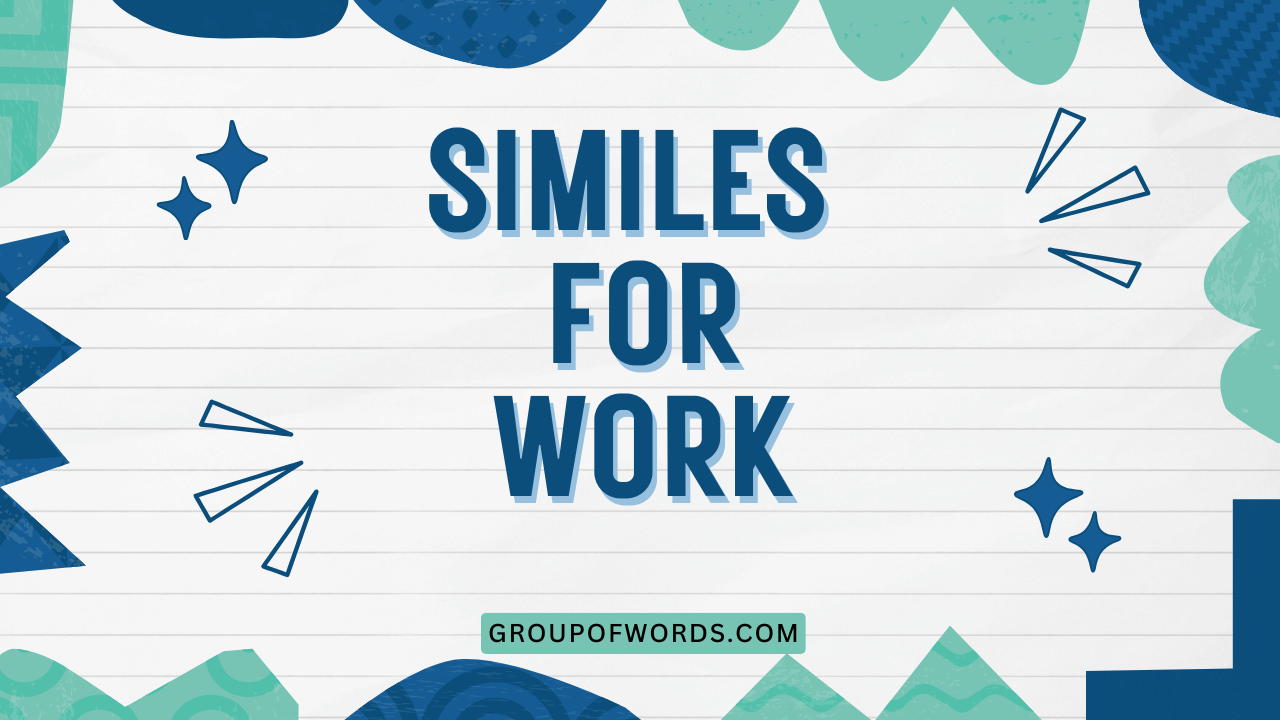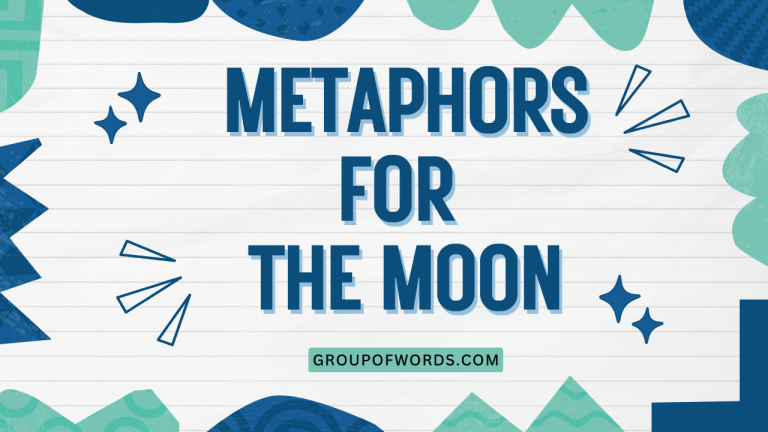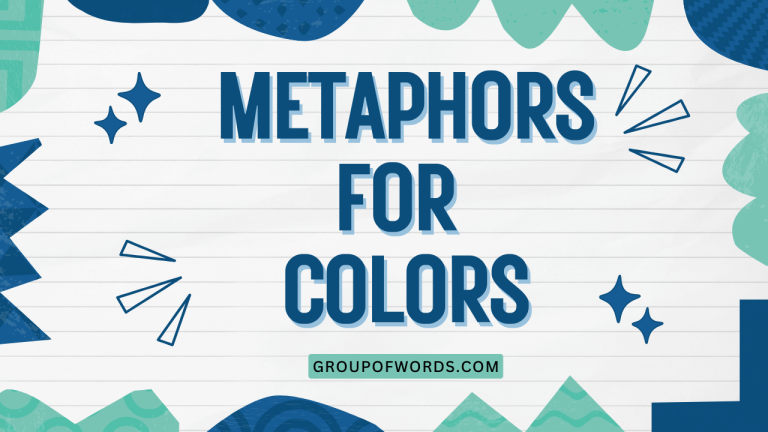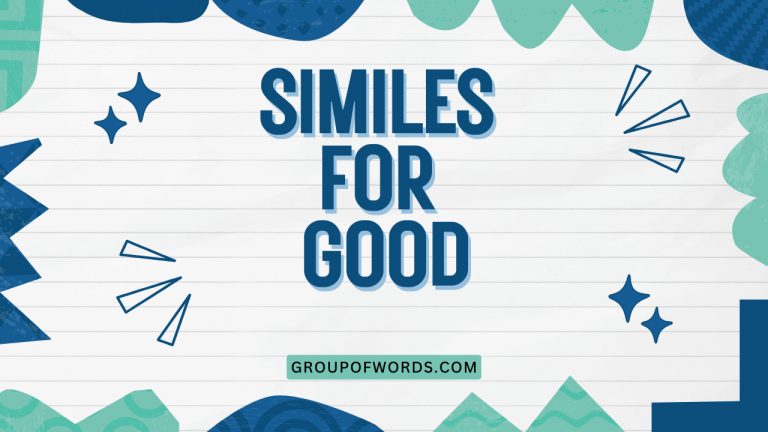Similes for Work: Enhancing Your Language at the Workplace
Understanding and using similes can significantly enhance your communication skills, especially in a professional environment. Similes add color, clarity, and impact to your speech and writing, making complex ideas more accessible and engaging.
This article provides a comprehensive guide to using similes effectively in the context of work. Whether you’re a student, a seasoned professional, or simply looking to improve your English language skills, this guide will equip you with the knowledge and tools to master similes and confidently apply them in various workplace scenarios.
By exploring the definition, structure, types, and usage rules of similes, you’ll gain a deeper appreciation for their power and versatility. Through numerous examples, practice exercises, and a thorough FAQ section, you’ll be well-prepared to incorporate similes into your daily interactions and written communications at work, making you a more effective and persuasive communicator.
Table of Contents
- Introduction
- Definition of a Simile
- Classification of Similes
- Function of Similes
- Context of Similes
- Structural Breakdown of Similes
- Basic Structure
- Comparison Elements
- Types and Categories of Similes
- Descriptive Similes
- Exaggerative Similes
- Ironic Similes
- Examples of Similes for Work
- Similes for Productivity
- Similes for Teamwork
- Similes for Leadership
- Similes for Stress
- Similes for Communication
- Usage Rules for Similes
- Clarity and Relevance
- Avoiding Cliches
- Cultural Sensitivity
- Common Mistakes When Using Similes
- Incorrect Comparisons
- Misused Linking Words
- Practice Exercises
- Exercise 1: Identifying Similes
- Exercise 2: Completing Similes
- Exercise 3: Creating Similes
- Advanced Topics in Similes
- Extended Similes
- Metaphor vs. Simile
- Frequently Asked Questions (FAQ)
- Conclusion
Definition of a Simile
A simile is a figure of speech that directly compares two different things, explicitly using the words “like” or “as.” The purpose of a simile is to create a vivid image, emphasize a particular quality, or make a concept more understandable by relating it to something familiar. Unlike a metaphor, which implies a direct equivalence, a simile acknowledges that the two things being compared are distinct but share a common characteristic.
For instance, saying “He works like a machine” is a simile because it compares his work ethic to that of a machine, using the word “like.” This suggests he is efficient, tireless, and consistent in his work. Similes are powerful tools for enhancing communication by adding color and depth to language.
Classification of Similes
Similes can be classified based on the type of comparison they make and the effect they create. Here are a few classifications:
- Descriptive Similes: These similes aim to provide a clear and vivid description of something by comparing it to something else with similar qualities.
- Emphatic Similes: Used to emphasize a particular characteristic or quality, making it more memorable or impactful.
- Figurative Similes: These similes rely on abstract or imaginative comparisons to create a poetic or artistic effect.
Function of Similes
The primary function of a simile is to make language more engaging and understandable. By drawing a comparison between two unlike things, similes can:
- Clarify complex ideas: Similes can simplify abstract concepts by relating them to concrete, familiar examples.
- Enhance descriptions: They add vividness and detail to descriptions, making them more memorable.
- Evoke emotions: Similes can create a specific emotional response by associating something with a feeling or experience.
- Add style: Using similes can make writing or speech more creative and interesting.
Context of Similes
The context in which a simile is used is crucial for its effectiveness. A simile that works well in one situation may be inappropriate or confusing in another.
Consider the audience, the subject matter, and the overall tone of the communication. In a professional setting, it’s important to use similes that are clear, relevant, and respectful to avoid misinterpretations or offense.
Structural Breakdown of Similes
Understanding the structure of a simile is essential for creating and interpreting them effectively. The basic structure involves two elements being compared, connected by a linking word.
Basic Structure
A simile typically follows this structure:
Subject + Linking Word + Object of Comparison
Where:
- Subject: The thing being described.
- Linking Word: Usually “like” or “as.”
- Object of Comparison: The thing to which the subject is being compared.
For example: “Her dedication is like a beacon.” Here, “dedication” is the subject, “like” is the linking word, and “a beacon” is the object of comparison.
Comparison Elements
The effectiveness of a simile depends on the strength and relevance of the comparison between the subject and the object. The two elements should share a common characteristic that is being highlighted.
The linking word (“like” or “as”) establishes the relationship between these elements, making it clear that a comparison is being made rather than a direct identification.
Consider this example: “He is as steady as a rock.” Here, the common characteristic is steadiness or reliability. The simile conveys that the person is dependable and unwavering, just like a rock.
Types and Categories of Similes
Similes can be categorized based on their purpose and the effect they create. Understanding these categories can help you choose the most appropriate simile for a given situation.
Descriptive Similes
Descriptive similes are used to create a vivid picture in the reader’s mind by comparing something to an object or concept with similar qualities. These similes often appeal to the senses, providing a more concrete understanding of the subject.
Example: “The office was as quiet as a library.” This simile helps the reader visualize the stillness and silence of the office.
Exaggerative Similes
Exaggerative similes, also known as hyperbole, are used to emphasize a point by comparing something to an extreme example. These similes are not meant to be taken literally but rather to highlight the intensity or magnitude of a particular quality.
Example: “He was as busy as a bee.” This simile exaggerates the person’s level of activity, suggesting they are extremely busy.
Ironic Similes
Ironic similes are used to convey a meaning that is the opposite of the literal words being used. These similes often create a humorous or sarcastic effect by highlighting the contrast between what is said and what is meant.
Example: “He’s as sharp as a marble.” This simile is ironic because marbles are not sharp, suggesting the person is not very intelligent.
Examples of Similes for Work
Here are several examples of similes that can be used in the workplace, categorized by common work-related themes.
Similes for Productivity
These similes describe aspects of productivity, efficiency, and work ethic.
The following table lists similes related to productivity, providing examples of how they can be used in a professional context.
| Simile | Explanation | Example Sentence |
|---|---|---|
| Works like a charm | Functions perfectly and effectively. | “The new software works like a charm, streamlining our workflow.” |
| As efficient as a well-oiled machine | Operates smoothly and without wasted effort. | “The team is as efficient as a well-oiled machine, completing projects ahead of schedule.” |
| As busy as a bee | Extremely active and engaged in tasks. | “During the conference, she was as busy as a bee, networking and attending sessions.” |
| Like clockwork | Happening at regular intervals and reliably. | “The project meetings run like clockwork, starting and ending on time.” |
| As quick as lightning | Very fast and efficient. | “His response to the client’s inquiry was as quick as lightning.” |
| As productive as a factory | Produces a large amount of work. | “This quarter, our sales team has been as productive as a factory, exceeding all targets.” |
| Like a well-tuned engine | Performing optimally and efficiently. | “The department operates like a well-tuned engine, with everyone contributing effectively.” |
| As steady as a rock | Reliable and consistent in performance. | “He is as steady as a rock; we can always count on him to deliver.” |
| Like a tireless worker | Working without getting tired or giving up. | “She approaches every task like a tireless worker, never complaining about the workload.” |
| As sharp as a tack | Very intelligent and quick-witted. | “Our new intern is as sharp as a tack and quickly grasps complex concepts.” |
| Like a human dynamo | Full of energy and enthusiasm. | “He’s like a human dynamo, always bringing energy to the team.” |
| As methodical as a surgeon | Extremely careful and precise. | “Her approach to data analysis is as methodical as a surgeon’s.” |
| Like a laser beam | Focused and direct. | “He tackled the problem like a laser beam, cutting straight to the solution.” |
| As focused as an eagle | Concentrated and attentive. | “During presentations, she’s as focused as an eagle, catching every detail.” |
| Like a Swiss watch | Precise and reliable. | “The project timeline is running like a Swiss watch, perfectly on schedule.” |
| As diligent as an ant | Hardworking and persistent. | “He is as diligent as an ant, always completing his tasks thoroughly.” |
| Like a whirlwind | Energetic and fast-paced. | “She came into the office like a whirlwind, getting everything organized in no time.” |
| As smooth as silk | Effortless and seamless. | “The presentation went as smooth as silk, thanks to thorough preparation.” |
| Like a well-oiled cog | A crucial and efficient part of a larger system. | “Each team member functions like a well-oiled cog in the project’s success.” |
| As consistent as sunrise | Reliable and predictable in performance. | “Her quality of work is as consistent as sunrise; you can always rely on it.” |
Similes for Teamwork
These similes describe the dynamics, collaboration, and effectiveness of teams.
The following table illustrates similes commonly used to describe effective and collaborative teamwork in a professional environment.
| Simile | Explanation | Example Sentence |
|---|---|---|
| Like a well-rehearsed orchestra | Working harmoniously and in sync. | “The team functions like a well-rehearsed orchestra, with each member playing their part flawlessly.” |
| As cohesive as glue | Sticking together and supporting each other. | “The department is as cohesive as glue, working together to overcome any challenge.” |
| Like a flock of birds | Moving in unison and with a common goal. | “During the crisis, the team acted like a flock of birds, communicating and moving in unison.” |
| As synchronized as dancers | Coordinated and working in perfect harmony. | “Their efforts were as synchronized as dancers, achieving the project goals effortlessly.” |
| Like pieces of a puzzle | Fitting together perfectly to create a whole. | “Each team member’s skills are like pieces of a puzzle, complementing each other perfectly.” |
| As cooperative as beavers | Working together diligently to achieve a common goal. | “The project team was as cooperative as beavers, building a successful product.” |
| Like a relay race | Passing responsibilities smoothly and efficiently. | “Handing off tasks is like a relay race, ensuring a seamless transition.” |
| As supportive as a family | Providing encouragement and assistance to each other. | “The team is as supportive as a family, always there to help each other out.” |
| Like a hive of activity | Busy and productive, with everyone contributing. | “The marketing department is always like a hive of activity during campaign launches.” |
| As united as one voice | Speaking and acting with a common purpose. | “The employees stood as united as one voice in support of the new policy.” |
| Like a symphony | A harmonious blend of different talents and skills. | “The project’s success was like a symphony, with each department contributing its unique talent.” |
| As interwoven as a tapestry | Complex and interconnected, with each part contributing to the whole. | “The team’s efforts are as interwoven as a tapestry, creating a beautiful and intricate result.” |
| Like a bridge | Connecting different departments and facilitating collaboration. | “She acted like a bridge between the engineering and marketing teams.” |
| As resourceful as a scout troop | Finding creative solutions and overcoming obstacles. | “The team was as resourceful as a scout troop, finding innovative ways to meet the deadline.” |
| Like a well-oiled machine | Working smoothly and efficiently together. | “The customer service department operates like a well-oiled machine, resolving issues quickly.” |
| As collaborative as artists | Sharing ideas and working together creatively. | “The design team is as collaborative as artists, brainstorming and creating innovative designs.” |
| Like a sports team | Working together towards a common goal, supporting each other. | “The sales force functions like a sports team, cheering each other on to achieve their targets.” |
| As harmonious as a choir | Working together in perfect agreement and unity. | “The board of directors is as harmonious as a choir, making decisions with consensus.” |
| Like a network of roots | Interconnected and providing support. | “The employees are like a network of roots, supporting the company’s growth.” |
| As responsive as a well-trained team | Reacting quickly and effectively to challenges. | “The emergency response team was as responsive as a well-trained team during the crisis.” |
Similes for Leadership
These similes describe the qualities and actions of effective leaders.
The table below provides examples of similes used to describe effective leadership qualities and actions in a professional setting.
| Simile | Explanation | Example Sentence |
|---|---|---|
| Like a guiding star | Providing direction and inspiration. | “The CEO acted like a guiding star, leading the company through challenging times.” |
| As strong as an oak | Resilient and unwavering in the face of adversity. | “Her leadership was as strong as an oak, providing stability during the merger.” |
| Like a beacon of hope | Inspiring confidence and optimism. | “His speech was like a beacon of hope, reassuring employees during the restructuring.” |
| As visionary as an architect | Envisioning the future and creating a plan to achieve it. | “She is as visionary as an architect, designing innovative strategies for growth.” |
| Like a captain of a ship | Steering the team towards success. | “He led the project like a captain of a ship, navigating through obstacles.” |
| As decisive as a judge | Making clear and fair decisions. | “Her decisions are as decisive as a judge’s, ensuring fairness and clarity.” |
| Like a conductor of an orchestra | Coordinating and harmonizing different talents. | “The manager led the team like a conductor of an orchestra, bringing out the best in everyone.” |
| As empowering as a mentor | Encouraging and supporting others to reach their full potential. | “His guidance was as empowering as a mentor’s, helping employees develop their skills.” |
| Like a lighthouse | Providing guidance and warning of potential dangers. | “The risk manager acted like a lighthouse, warning the company of potential pitfalls.” |
| As strategic as a chess player | Planning ahead and anticipating potential challenges. | “Her approach to business development is as strategic as a chess player’s.” |
| Like a gardener | Nurturing and growing talent within the organization. | “The HR director nurtured employees like a gardener, helping them flourish.” |
| As fearless as a lion | Courageous and willing to take risks. | “Her leadership was as fearless as a lion’s, taking bold steps to innovate.” |
| Like a compass | Providing direction and guidance. | “The company’s mission statement acted like a compass, guiding our decisions.” |
| As balanced as a tightrope walker | Maintaining equilibrium and stability during challenging situations. | “His leadership was as balanced as a tightrope walker, navigating through market volatility.” |
| Like a catalyst | Inspiring change and accelerating progress. | “Her arrival was like a catalyst, accelerating the company’s growth.” |
| As inspiring as a motivational speaker | Motivating and energizing others. | “His speeches are as inspiring as a motivational speaker’s, boosting employee morale.” |
| Like a shield | Protecting the team from external pressures. | “The manager acted like a shield, protecting the team from unnecessary stress.” |
| As clear as a bell | Communicating messages directly and transparently. | “Her communication style is as clear as a bell, leaving no room for confusion.” |
| Like a bridge builder | Connecting different departments and facilitating collaboration. | “She acted like a bridge builder, fostering communication between teams.” |
| As adaptable as a chameleon | Adjusting to changing circumstances and environments. | “His leadership was as adaptable as a chameleon, adjusting to market changes effectively.” |
Similes for Stress
These similes describe feelings of stress, pressure, and overwhelm in the workplace.
The following table provides examples of similes used to describe feelings of stress, pressure, and overwhelm in a professional environment.
| Simile | Explanation | Example Sentence |
|---|---|---|
| Like a pressure cooker | Feeling intense pressure and on the verge of exploding. | “The workload felt like a pressure cooker, and I was on the verge of burnout.” |
| As stressed as a tightrope | Feeling stretched thin and close to breaking. | “After the deadline, I felt as stressed as a tightrope, needing a long vacation.” |
| Like a squeezed lemon | Feeling drained and exhausted. | “By the end of the week, I felt like a squeezed lemon, completely depleted of energy.” |
| As overwhelmed as a flood victim | Feeling completely inundated with tasks and responsibilities. | “With the new project, I felt as overwhelmed as a flood victim, struggling to keep my head above water.” |
| Like a ticking time bomb | Feeling anxious and expecting something bad to happen. | “The uncertainty felt like a ticking time bomb, waiting for the inevitable bad news.” |
| As tense as a drum | Feeling extremely nervous and on edge. | “Before the presentation, I was as tense as a drum, barely able to speak.” |
| Like a tangled web | Feeling trapped and confused by complex problems. | “The project’s issues felt like a tangled web, and I didn’t know where to start.” |
| As burdened as a pack mule | Feeling weighed down by responsibilities. | “With all the extra tasks, I felt as burdened as a pack mule, carrying too much weight.” |
| Like a storm brewing | Feeling a build-up of tension and anxiety. | “The atmosphere in the office felt like a storm brewing, with everyone on edge.” |
| As frazzled as a wire | Feeling worn out and unable to cope. | “After the long hours, I felt as frazzled as a wire, unable to think straight.” |
| Like a ship lost at sea | Feeling directionless and uncertain. | “Without clear guidance, I felt like a ship lost at sea, unsure of what to do.” |
| As strained as a rubber band | Feeling stretched beyond capacity. | “The team felt as strained as a rubber band, close to snapping under the pressure.” |
| Like a machine overheating | Feeling close to a breaking point due to stress. | “I felt like a machine overheating, needing to shut down and cool off.” |
| As rattled as a snake | Feeling agitated and easily startled. | “After the criticism, I was as rattled as a snake, jumping at every sound.” |
| Like a deer in headlights | Feeling paralyzed by fear and unable to react. | “When asked the question, I felt like a deer in headlights, unable to answer.” |
| As overwhelmed as a student before finals | Feeling intensely stressed due to numerous demands. | “With the project deadline looming, I felt as overwhelmed as a student before finals.” |
| Like a volcano about to erupt | Feeling a build-up of anger and frustration. | “I felt like a volcano about to erupt, trying to contain my frustration.” |
| As exhausted as a marathon runner | Feeling completely worn out after a long period of intense effort. | “After the project’s completion, I felt as exhausted as a marathon runner.” |
| Like a leaf in a storm | Feeling helpless and tossed around by circumstances. | “I felt like a leaf in a storm, tossed around by the company’s changes.” |
| As shattered as glass | Feeling broken and unable to recover. | “After the failure, I felt as shattered as glass, needing time to heal.” |
Similes for Communication
These similes describe the clarity, effectiveness, and style of communication in the workplace.
The table below provides examples of similes used to describe the clarity, effectiveness, and style of communication in a professional environment.
| Simile | Explanation | Example Sentence |
|---|---|---|
| As clear as a bell | Easy to understand and unambiguous. | “Her explanation was as clear as a bell, leaving no room for confusion.” |
| Like a broken record | Repetitive and annoying. | “He sounds like a broken record, always repeating the same complaints.” |
| As smooth as silk | Effortless and graceful. | “His presentation was as smooth as silk, captivating the audience.” |
| Like a breath of fresh air | Refreshing and revitalizing. | “Her ideas were like a breath of fresh air, bringing new perspectives to the team.” |
| As sharp as a knife | Direct and incisive. | “Her feedback was as sharp as a knife, cutting straight to the point.” |
| Like a tangled thread | Confusing and difficult to follow. | “His explanation was like a tangled thread, making it hard to understand the process.” |
| As persuasive as a lawyer | Convincing and influential. | “Her arguments were as persuasive as a lawyer’s, swaying the board’s decision.” |
| Like a well-written novel | Engaging and captivating. | “The report read like a well-written novel, keeping the reader interested.” |
| As vague as a cloud | Unclear and lacking detail. | “His instructions were as vague as a cloud, leaving us unsure of what to do.” |
| Like a double-edged sword | Having both positive and negative consequences. | “The new policy is like a double-edged sword, offering benefits but also creating challenges.” |
| As warm as sunshine | Friendly and welcoming. | “Her communication style is as warm as sunshine, making everyone feel comfortable.” |
| Like a maze | Complex and confusing. | “Navigating the company’s bureaucracy felt like a maze.” |
| As direct as an arrow | Straightforward and to the point. | “Her email was as direct as an arrow, clearly stating her expectations.” |
| Like a soothing balm | Calming and comforting. | “His words were like a soothing balm, easing our anxieties.” |
| As forceful as a hammer | Strong and impactful. | “Her arguments were as forceful as a hammer, driving the point home.” |
| Like a whisper in the wind | Easily missed or ignored. | “His suggestions were like a whisper in the wind, barely noticed by the team.” |
| As eloquent as a poet | Expressive and articulate. | “Her speech was as eloquent as a poet’s, moving the audience to tears.” |
| Like a filter | Removing unnecessary information and focusing on the essentials. | “He acted like a filter, summarizing the key points of the meeting.” |
| As resonant as a gong | Clear and memorable. | “Her message was as resonant as a gong, leaving a lasting impression.” |
| Like a mirror | Reflecting back what is being said or felt. | “Her responses were like a mirror, reflecting back our concerns and showing understanding.” |
Usage Rules for Similes
Using similes effectively requires an understanding of certain rules and guidelines. These rules ensure that your similes are clear, appropriate, and impactful.
Clarity and Relevance
A good simile should be clear and easy to understand. The comparison should be relevant to the subject being described, and the connection between the two elements should be obvious.
Avoid using obscure or overly complex comparisons that may confuse the audience. The goal is to enhance understanding, not to create ambiguity.
For example, instead of saying “His work is like a quantum entanglement,” which may be confusing to many, say “His work is as precise as a surgeon’s.”
Avoiding Cliches
Cliches are overused similes that have lost their impact due to frequent use. While they may be easy to remember, they often lack originality and can make your writing or speech sound uninspired.
Instead of relying on cliches, try to create fresh and original similes that are tailored to the specific context.
Instead of using the cliche “as busy as a bee,” consider a more original simile like “as busy as a project manager during a product launch.”
Cultural Sensitivity
Be mindful of cultural differences and sensitivities when using similes. A simile that is appropriate and understandable in one culture may be offensive or confusing in another.
Consider the cultural background of your audience and choose comparisons that are universally understood and respectful. When in doubt, it’s best to avoid similes that rely on specific cultural references or stereotypes.
Common Mistakes When Using Similes
Even experienced writers and speakers can make mistakes when using similes. Being aware of these common errors can help you avoid them and use similes more effectively.
Incorrect Comparisons
One common mistake is making comparisons that don’t make sense or are illogical. The two elements being compared should share a meaningful characteristic.
If the connection is too weak or unclear, the simile will be ineffective.
Incorrect: “His presentation was like a potato.” (There is no clear connection between a presentation and a potato.)
Correct: “His presentation was as dry as a desert.” (This suggests the presentation was boring and unengaging.)
Misused Linking Words
Using the wrong linking word can also lead to confusion. Similes should use “like” or “as” to indicate a comparison.
Using other words can create a metaphor or a different type of figurative language.
Incorrect: “He is a lion on the battlefield.” (This is a metaphor, not a simile.)
Correct: “He is like a lion on the battlefield.” (This is a simile, comparing his bravery to that of a lion.)
Practice Exercises
Test your understanding of similes with these practice exercises. Each exercise focuses on a different aspect of simile usage.
Exercise 1: Identifying Similes
Identify the similes in the following sentences.
| Question | Answer |
|---|---|
| 1. Her ideas are as bright as the stars. | as bright as the stars |
| 2. The project manager is a rock for the team. | (No simile – this is a metaphor) |
| 3. The office was as quiet as a tomb. | as quiet as a tomb |
| 4. He works like a machine. | like a machine |
| 5. The deadline loomed, a dark cloud over the team. | (No simile – this is a metaphor) |
Exercise 2: Completing Similes
Complete the following similes with an appropriate comparison.
- The new software runs like __________.
- He is as reliable as __________.
- The office was as chaotic as __________.
- She handled the crisis like __________.
- His explanation was as clear as __________.
Possible Answers:
- The new software runs like a dream.
- He is as reliable as clockwork.
- The office was as chaotic as a playground.
- She handled the crisis like a pro.
- His explanation was as clear as crystal.
Exercise 3: Creating Similes
Create your own similes to describe the following scenarios.
- Describe a busy office environment.
- Describe a challenging project.
- Describe an effective team.
- Describe a stressful day at work.
- Describe a successful presentation.
Example Answers:
- The busy office environment was like a beehive, buzzing with activity.
- The challenging project was like climbing Mount Everest, requiring immense effort and determination.
- The effective team was like a well-oiled machine, working seamlessly together.
- The stressful day at work was like navigating a minefield, full of potential dangers and obstacles.
- The successful presentation was as smooth as silk, captivating the audience from start to finish.
Advanced Topics in Similes
Explore more complex aspects of similes, including extended similes and the distinction between similes and metaphors.
Extended Similes
An extended simile is a simile that is developed over several lines or sentences. It allows for a more detailed and elaborate comparison, providing a deeper understanding of the subject.
Extended similes are often used in literature and creative writing to create a more vivid and impactful image.
Example:
“The project was like a long and winding road, full of unexpected turns and challenges. Each obstacle was like a steep hill, requiring extra effort to climb.
But with each challenge overcome, the team grew stronger, like a tree weathering a storm.”
Metaphor vs. Simile
While both metaphors and similes are figures of speech that make comparisons, they differ in their approach. A simile explicitly uses “like” or “as” to draw a comparison, while a metaphor implies a direct equivalence between two things.
Simile: “He is as brave as a lion.” (Compares his bravery to that of a lion.)
Metaphor: “He is a lion on the battlefield.” (Implies he is a lion, representing bravery.)
Metaphors are often considered more powerful and direct, while similes are more cautious and descriptive. The choice between a metaphor and a simile depends on the desired effect and the context of the communication.
Frequently Asked Questions (FAQ)
Find answers to common questions about similes and their usage.
What is the difference between a simile and a metaphor?
A simile uses “like” or “as” to make a comparison, while a metaphor implies a direct equivalence without using these words.
Can a simile be a cliche?
Yes, if a simile is overused and has lost its originality, it becomes a cliche.
How can I create effective similes?
Choose comparisons that are clear, relevant, and original. Avoid cliches and consider the audience and context.
Is it okay to use similes in formal writing?
Yes, but use them sparingly and ensure they enhance clarity and understanding rather than detracting from the formality.
What if my audience doesn’t understand my simile?
Choose comparisons that are universally understood or provide context to explain the connection between the elements being compared.
Conclusion
Mastering the art of using similes can significantly enhance your communication skills in the workplace. By understanding the definition, structure, types, and usage rules of similes, you can add color, clarity, and impact to your speech and writing.
Remember to choose comparisons that are clear, relevant, and original, and to avoid cliches and cultural insensitivity. With practice and attention to detail, you can confidently incorporate similes into your daily interactions and written communications, making you a more effective and persuasive communicator in any professional environment.
Embrace the power of similes, and watch your language skills soar to new heights.






